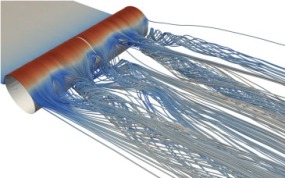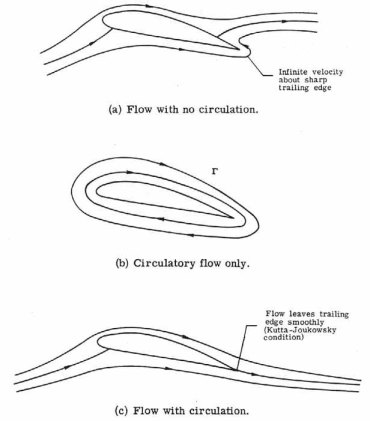The New Theory of Flight presented on this site explains the generation of both lift and drag of a wing as the result of Natures ingenious modification of zero lift/drag potential flow at the trailing edge, by a certain separation mechanism, which allows the flow to leave the wing smoothly without the high pressure of potential flow.
The secret of flight is thus directly connected to the separation mechanism which we refer to as
- rotational slip separation
illustrated in the following picture showing separation from a circular cylinder:
Rotational slip separation arises from a basic instability of potential flow, and can thus be seen as Natures way of handling an unstable solution with a singularity. Rotational slip separation is thus a physical mechanism which is observed in both computational simulation solving the Navier-Stokes equations with a slip boundary condition, and in physical experiments.
The New Theory is to be compared with the classical Kutta-Zhukovsky theory of lift, which modifies potential flow by a large scale circulation around the wing section which is neither observed in computation nor in physical experiments, but anyway shown in this fantasy picture with the singularity of potential flow at the trailing edge a reality:
The New Theory thus solves the problem Kutta-Zhukovsky set out to solve, namely to identify how Nature avoids the potential flow separation at the trailing edge which destroys lift.
Kutta-Zhukovsky theory requires the trailing edge to be sharp, which is not fulfilled in practice, while the New Theory describes reality with a more or less sharply rounded or flat-cut trailing edge.
Kutta-Zhukovsky theory gives lift from non-physical circulation, but no drag, and drag of a wing is then supposed to be covered by Prandtl’s boundary layer theory. Classical flight theory thus consists of two separate theories, on for lift without drag, and another for drag without lift.
The New Theory gives both lift and drag in accordance with observation without both circulation and boundary layers, and thus shows that classical theory has no role to serve. Major work to rewrite textbooks will be required.




Michele
I think that the vorticities at the trailing edge of the airfoil must come perpendicular to the mainstream and then arrange according to this splitting themselves into two counter-rotating vortices. That is, there must form few horseshoe vortices and the fluid-dynamic effect is better.